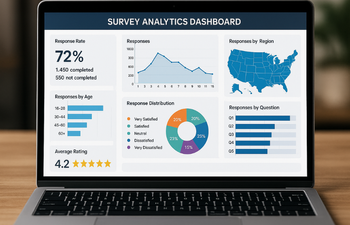How to Boost Your Survey Response Rate: 7 Proven Tips
Learn how to boost your survey response rate with 7 proven tips that drive higher engagement and better feedback.

Introduction
Surveys are invaluable tools for gathering feedback, gauging satisfaction, and guiding decisions. But getting people to actually respond? That’s the real challenge. Whether you're a marketer, product manager, or researcher, improving your survey response rate is crucial. Here’s a comprehensive guide to help you understand what affects response rates and how to boost them with 7 actionable and proven strategies.
Why Survey Response Rate Matters
The survey response rate is more than just a metric, it reflects how representative your data is. A low response rate can skew results, leading to flawed conclusions and poor decisions. High response rates, on the other hand, increase confidence in the data and enhance the validity of your research.
Moreover, surveys with strong participation often generate more nuanced and honest feedback. Engaged respondents are more likely to share thoughts, ideas, and concerns that can drive innovation and improvement.
Understand the Barriers to Survey Completion
Before you can boost your response rate, you need to understand why people aren’t completing your surveys. Common barriers include:
- Lengthy or confusing questions
- Lack of perceived value or benefit
- Poor timing or irrelevant content
- Concerns over privacy or misuse of data
- Technical issues or unoptimized survey design
By addressing these issues, you lay the groundwork for a higher engagement rate.
Optimize the Timing of Your Survey
When you send your survey matters just as much as what you ask. Research consistently shows that midweek (Tuesday through Thursday) sees the highest open and response rates. Avoid sending surveys late at night or over the weekend unless your audience specifically operates during those hours.
Timing also involves context. For example, post-purchase surveys should be sent shortly after the transaction, while employee engagement surveys may be better suited at quarter-ends or after major internal changes.
Keep It Short and Focused
Long-winded surveys are response-rate killers. Aim for brevity and precision. Ideally, your survey should take no more than 5-10 minutes to complete. That usually translates to fewer than 15 questions, unless you're targeting a particularly invested audience.
Use logic branching to skip irrelevant questions and keep users engaged. Show a progress bar so respondents know how far they’ve come.
Personalize the Invitation
Generic emails get ignored. Personalize your survey invitation by including the recipient’s name, referencing a recent interaction, or tailoring it to their role or interests.
You can also segment your audience to create more relevant messaging. Personalization increases the feeling of importance and connection, making people more likely to respond.
Offer a Clear Value Proposition
People are more likely to participate in a survey if they see a clear benefit. This could be:
- A chance to influence a product they use
- Early access to results or insights
- Entry into a prize draw or discount
- Contribution to a social cause
Be honest and transparent about how their feedback will be used. Emphasize the impact their response can have.
Use Incentives Wisely
Incentives can be powerful motivators, especially when the perceived effort outweighs the benefit. Offer something relevant and proportionate to the time commitment. Common incentives include:
For a deeper look at which incentives actually drive participation, and which can backfire, see Incentives in Surveys: What Works and What Backfires.
Make sure the incentive doesn’t bias the responses. Avoid offering rewards that might encourage people to rush through just to get the prize.
Improve Mobile Compatibility
With more people completing surveys on their phones, mobile optimization is no longer optional. Your survey must load quickly, display correctly on various screen sizes, and be easy to navigate with touch inputs.
Avoid open-ended questions that require long typing on mobile devices. Use radio buttons, sliders, and drop-downs to make answering faster and simpler.
Use Engaging Survey Design
Design affects user behavior. A clean, modern, and visually appealing survey is more inviting than a dull or text-heavy one. Use your brand’s color scheme and logo, but keep the design uncluttered.
Incorporate elements like:
- Progress indicators
- Conditional logic to hide irrelevant questions
- Clear, concise instructions
- Error handling for required fields
These small tweaks can significantly improve the user experience and completion rate.
A/B Test Your Survey Invitations
Don’t guess, test. A/B testing lets you experiment with different subject lines, messaging styles, send times, and formats to see what gets the best response.
Track metrics like open rates, click-through rates, and completions. Then, double down on what works.
Send Reminders (But Don’t Annoy)
One follow-up can increase your response rate by 15-30%. But bombardment will irritate people and damage your brand. Stick to one or two polite reminders spaced a few days apart.
Make sure the tone is courteous and appreciative. Reinforce the value of their participation and remind them of any incentives.
Craft Clear and Concise Questions
Ambiguous or complicated questions confuse respondents and lead to inaccurate answers. Stick to simple, direct language. Avoid jargon, double-barreled questions, and leading phrases.
If you want to avoid the most common pitfalls, check out Survey Question Mistakes That Are Ruining Your Response Rate for practical tips.
For example, instead of asking, “How satisfied and likely are you to recommend our service?” split it into two separate questions.
Use Multiple Channels
Don’t limit yourself to email. Depending on your audience, you can also distribute surveys via:
- SMS
- In-app notifications
- Website pop-ups
- Social media
Each channel has its own strengths. Use analytics to understand where your audience is most active and tailor your outreach accordingly.
Segment Your Audience
Segmentation allows you to target different groups with tailored messaging and relevant questions. A one-size-fits-all survey often leads to poor engagement.
Break your audience down by:
- Demographics
- Behavior
- Purchase history
- Location
Then, craft different versions of your survey or invitation that speak directly to those segments.
Analyze and Iterate
Once your survey closes, don’t just file it away. Analyze completion rates, drop-off points, and question-by-question responses to see what worked, and what didn’t.
Apply these lessons to future surveys to continuously improve your strategy and outcomes.
Maintain Transparency and Trust
Today’s users are wary of data misuse. Be upfront about:
- Why you’re collecting data
- How it will be used
- How you’ll protect their privacy
Consider adding a short statement at the beginning of the survey. Build trust, and you'll boost engagement.
Leverage Social Proof
Mentioning how many others have participated in a survey can motivate more people to join. For example:
“Join over 2,000 customers who’ve shared their feedback!”
Social proof taps into the herd mentality and reassures respondents that their time will be well spent.
Tailor Language to Your Audience
Speak your audience’s language, literally and figuratively. Use terminology they understand and resonate with. A formal tone might work for professionals, while a more casual voice could be better for consumers.
Localization also plays a role. If you’re surveying global users, offer translations or culturally adapted versions.
Conclusion
Improving your survey response rate isn’t about luck, it’s about strategy. By optimizing every aspect of your survey from timing to design, language to incentives, you can engage your audience, collect better data, and make more informed decisions.
Remember, the key is to respect your respondents’ time, show appreciation, and deliver real value. Implement these 7 proven tips, and you’ll be well on your way to higher participation and more actionable insights.
Frequently Asked Questions
Find answers to the most common questions about this topic
A good survey response rate typically ranges between 30% to 50%, depending on the audience and survey method.
Keep your survey short, use clear language, personalize where possible, and offer incentives to increase engagement.
Incentives can significantly improve response rates, especially when targeting a broad or less engaged audience.
Ideally, a survey should take no longer than 5-10 minutes to complete, which usually means fewer than 15 questions.
Yes, sending a follow-up email or reminder can greatly improve your response rate, especially if it's timed well.
Tuesday to Thursday are generally the best days to send surveys for higher open and response rates.









